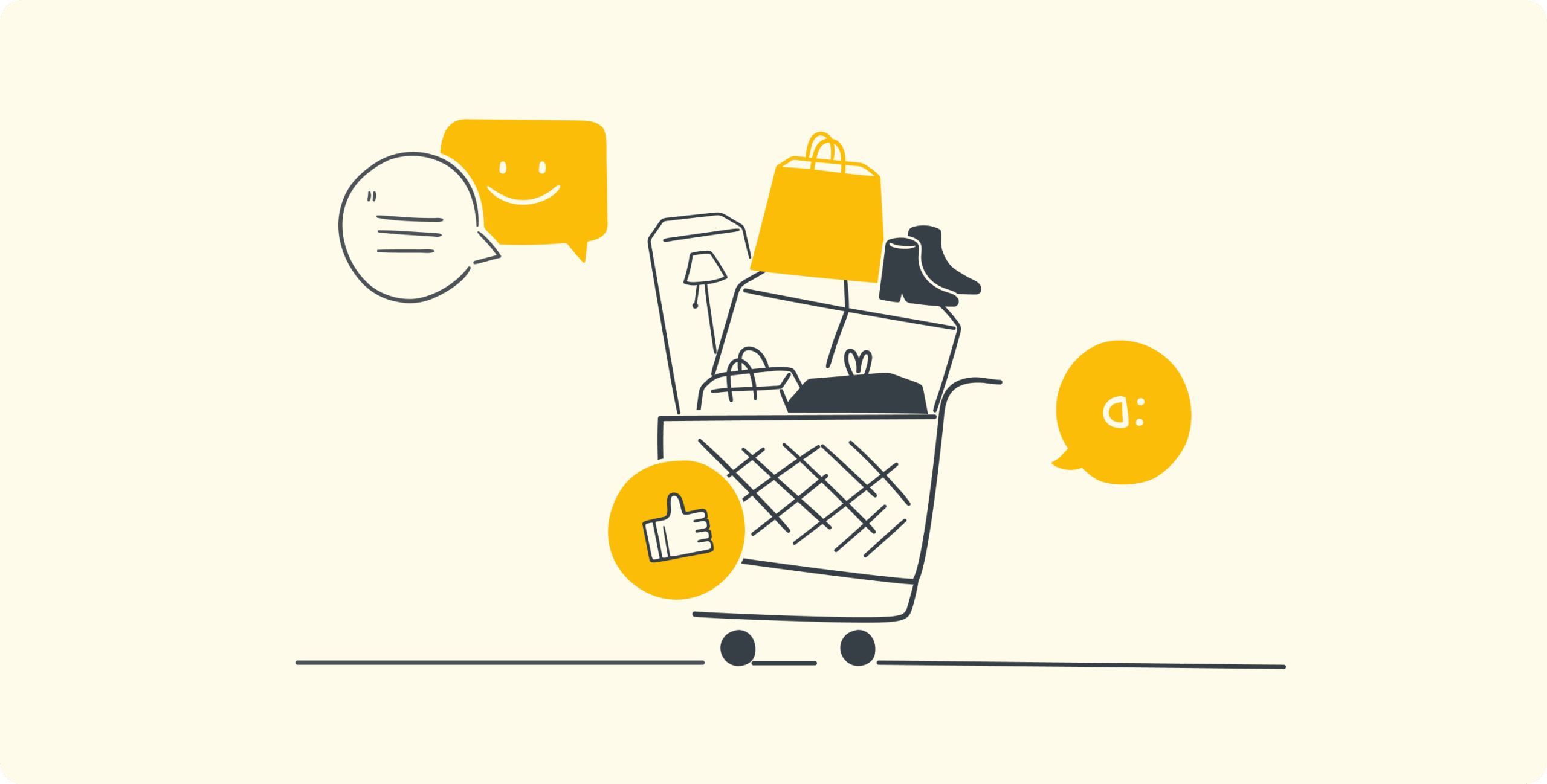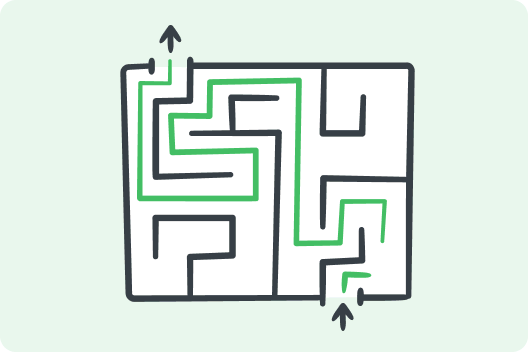In retail, customer satisfaction (CSAT) and Net Promoter Score (NPS) are fundamental indicators of loyalty and long-term business growth.
Shoppers today are quick to switch brands if their experience falls short. A single frustrating interaction can lead to churn, while a seamless and personalized journey fuels customer loyalty, retention, repeat purchases, and glowing recommendations.
Top retail brands use CSAT and NPS as leading indicators of revenue, not just afterthoughts in a quarterly report. By embedding feedback into everyday operations, they create a flywheel: customers share their opinions ➡ ️ employees act on the insights ➡ ️ business improves continuously.
But what does it take to actually improve CSAT and NPS in retail? It starts with asking the right questions to uncover gaps in customer experience and retention.
1. Is your customer service strong enough to truly raise CSAT and NPS?
Customers want to feel seen, heard, and valued. Personalized customer service is the differentiator that helps retail brands stand out in crowded markets. It sets the foundation for higher NPS and stronger loyalty. Better service isn’t just a “soft skill” — it’s one of the most direct retail growth strategies for boosting satisfaction and loyalty.
💪 Invest in training and empowerment. Teach your staff how to listen actively, anticipate customer needs, and respond with empathy. But it’s equally important to empower employees: they should have the freedom to make on-the-spot decisions like issuing refunds, offering alternatives, or providing personalized recommendations.
🔐 Use customer data responsibly. Personalization should build trust, not feel invasive. It works best when you use it for thoughtful touches like smart recommendations or small gestures of appreciation. Always stay compliant with privacy laws; avoid over-collecting or using data in ways that feel manipulative.
💞 Build a culture of service. Personalized service isn’t owned by one team — it’s an organization-wide mindset. Don’t treat service as a department, but as a shared responsibility that guides every decision. From product design to logistics to customer support, each role influences how your customers feel.
Read more: Is every department in your company making the most out of feedback?
Real-time customer feedback is non-negotiable in retail. Shoppers expect their voices to be heard instantly. Acting right away gains you a major advantage in improving customer experience and driving retail growth strategies that boost loyalty.
Start by making feedback effortless. Short, simple, and well-timed CSAT/NPS surveys, embedded at key touchpoints, drive far higher response rates. Your customers are much more likely to share their experience when the survey feels natural and relevant.
Equally important is closing the feedback loop fast. Acknowledge negative feedback right away, reach out with empathy to resolve any issues, and follow up to confirm satisfaction!
To uncover deeper insights, go beyond the numbers. Scores are helpful for benchmarking, but open-ended feedback reveals the “why” behind customer sentiment. You can use AI-powered sentiment analysis to process these comments at scale.
But even the most well-designed surveys can be overlooked! Encourage participation with small but meaningful incentives: loyalty points, discounts, or exclusive access for survey respondents.
💡 Add real-time alerts in Slack or your CRM so frontline teams can act before frustration hardens into churn. For proactive issue resolution, use AI to scan open-ended responses for early warning signs — phrases like “hard to find,” “took too long,” or “couldn’t complete.”
Acting on those signals immediately turns CSAT/NPS feedback into a retention tool.
Convenience is one of the strongest drivers of customer satisfaction in retail. Shoppers have endless options, and the brands they stay loyal to are the ones that make every step of the customer journey fast, simple, and frustration-free.
- Reduce friction at checkout. Even small improvements — like storing payment preferences, offering guest checkout, or adding one-click payment — can significantly reduce cart abandonment and improve NPS.
- Make returns effortless. Simple return policies and fast processing show customers that you value their time. This is a good way to reduce hesitation to purchase!
- Streamline customer support. Quick, accessible help channels (live chat, responsive agents, AI-powered assistants, etc.) resolve issues before they impact loyalty.
- Unify the journey across channels. Omnichannel experiences like synchronized loyalty programs and shared carts eliminate unnecessary friction.
💡 If you’re unsure where to start improving retail convenience, start deploying Customer Effort Score (CES) surveys at various checkpoints. CES highlights friction and provides a clear roadmap for improvement; paired with CSAT and NPS, it helps retail brands spot the exact moments that block loyalty and turn them into growth.
When employees feel valued, they deliver better service. And better service directly translates into stronger CSAT and higher NPS! It’s the key to continuously improving customer loyalty in retail.
🥳 Share customer feedback with your team. Too often, feedback lives in dashboards that only managers see. Why not make CSAT and NPS results visible across your organization? Celebrating positive comments energizes your team, while discussing negative feedback constructively creates learning opportunities. When employees see the direct link between their actions and customer satisfaction, their motivation goes up.
👍 Recognize and reward impact. Offer public recognition to employees who drive higher CSAT scores or receive positive survey comments. Simple shout-outs, peer-to-peer acknowledgments, and small rewards for great service go a long way.
🎓 Invest in coaching and development. Engaged employees aren’t just trained once; they’re coached continuously. Real-time feedback from managers helps staff self-correct and grow, while ongoing development signals to employees that the company is invested in their future.
📈 Measure engagement with eNPS. Just as NPS tracks customer loyalty, eNPS (Employee Net Promoter Score) measures employee advocacy. Are your team members likely to recommend your company as a great place to work? High eNPS scores correlate strongly with better customer outcomes. When employees feel valued, supported, and proud of their workplace, they naturally provide better service.
Read more: What is an employee engagement survey?
Customers don’t want to jump through hoops or decode a complicated points system. They want rewards that feel meaningful and tailored to their preferences.
- Don’t overwhelm the customer. Programs overloaded with tiers, rules, exceptions, and hidden restrictions create frustration. The best retail loyalty programs are clear and straightforward.
- Personalize rewards with customer data. Loyalty programs are also a chance to show customers you know them. Use their purchase history and behavioral data to create personalized offers like discounts on favorite categories.
💡 You can use loyalty programs as feedback engines! Embed short CSAT or NPS surveys within your program communications (such as app notifications or member emails) to build a steady stream of actionable feedback.
Improving CSAT and NPS often requires a cultural shift that starts with leadership. Executives set the tone by modeling customer-first behavior and making CX a priority in strategy discussions. Customer satisfaction metrics should be tied directly to business success, not just treated as a side note.
Every department shapes the customer journey. Operations can reduce delays, marketing sets realistic expectations, and product teams refine offerings based on feedback. When these functions work in isolation, your customers feel the gaps. But when they pull in the same direction, the CX becomes smoother and stays grounded in real customer needs.
💡 Don’t just measure CSAT and NPS in a silo. Connect them to clear outcomes like customer retention, repeat purchases, and referrals. Framing satisfaction metrics as growth drivers — not just vanity stats — motivates your team to keep improving.
The right tools don’t replace human service, they amplify it. Investing in customer feedback management software and AI in customer experience enables retail brands to deliver faster, more consistent experiences. This directly improves CSAT and NPS.
- Automate survey distribution — Instead of manually sending feedback requests, use customer feedback tools that automatically trigger CSAT and NPS surveys after key interactions.
- Turn data into action — Gathering responses is only the start. Advanced feedback platforms provide real-time analytics, dashboards, and alerts that make it easy to spot trends. For example, a sudden dip in NPS might highlight a fulfillment issue before it becomes a bigger problem.
In addition to improving efficiency, tech can be used to unlock a deeper understanding of customer needs. A high level of automation makes it easy to spot trends, act on insights, and continuously improve your CSAT and NPS scores.
It’s impossible to prevent every problem in retail. Products go out of stock, deliveries run late, mistakes happen. What sets high-performing brands apart is how they respond to these situations.
A strong service recovery strategy can turn a negative experience into loyalty. This is one of the fastest ways to improve CSAT, NPS, retention, and brand reputation.
Service recovery best practices
- Act instantly on negative feedback
- Set alerts for low CSAT or NPS scores
- Respond with speed and empathy
- Take ownership of mistakes
- Acknowledge the issue clearly
- Explain next steps transparently
- Offer refunds or replacements
- Provide discounts on future purchases
- Follow up after resolution
Customers don’t remember perfection; they remember how a brand responded when something went wrong. A well-handled recovery can turn disappointment into loyalty, and loyal customers into powerful advocates.
Read more: What is the service recovery paradox?
Real retail growth doesn’t come from chasing perfect scores. CSAT, NPS, and CES only matter when they lead to change. After all, numbers don’t build loyalty, action does.
👉 Close the loop fast
👉 Fix checkout frustrations
👉 Make returns simple
👉 Empower employees to act
👉 Recognize great service
👉 Use technology to catch issues early
When feedback drives action, customers feel it immediately. Service is faster, the shopping experience is easier, mistakes get fixed quickly, and customer support feels humans. Teams feel it too — seeing their work tied directly to customer satisfaction builds pride and a sense of task ownership. Together, these shifts create stronger retention, higher lifetime value, and real retail growth.
About Simplesat: Simplesat is the leading omnichannel survey app designed to enhance customer feedback management across various platforms, including Zendesk, Salesforce, and Gladly. Trusted by businesses worldwide, Simplesat delivers actionable insights that drive business growth and customer satisfaction.




